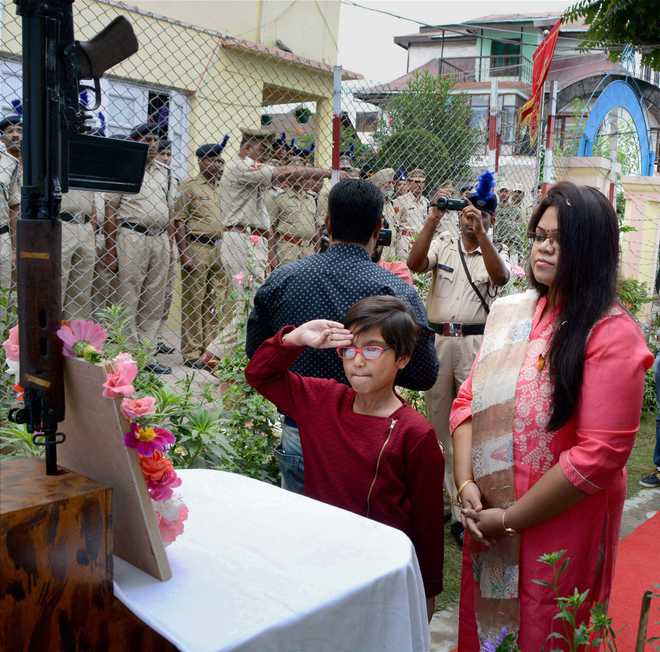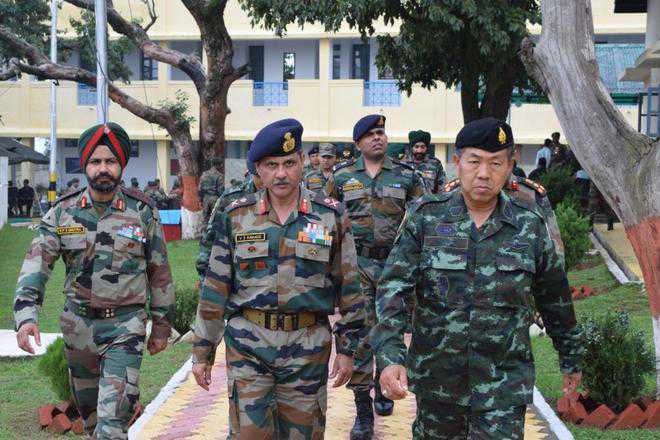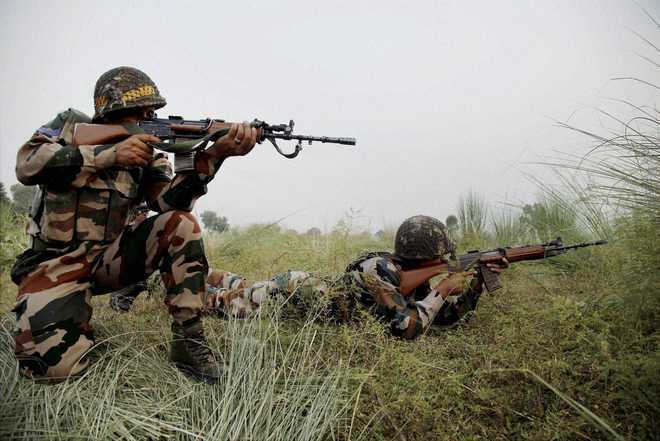
Martyred CRPF Commandant Pramod Kumar’s wife Neha Tripathi and six-year-old daughter Arna Kumar paying tribute to him, after unfurling the Tricolour during 71st Independence Day celebration at CRPF camp in Srinagar on Tuesday. PTI
Srinagar, August 15
The six-year-old daughter of slain CRPF Commandant Pramod Kumar and his wife on Tuesday unfurled the Tricolour at the same battalion camp here, where exactly a year ago he hoisted the flag and was killed minutes later in an encounter with militants.Kumar’s wife Neha Tripathy and daughter Aarna performed the ceremonial unfurling and saluting the flag at the 49th battalion camp in the Karan Nagar area.Tripathy then performed the traditional drill of distributing sweets to the men of the battalion, once commanded by her husband. She also placed a wreath at the martyr’s memorial built at the camp.Kumar (44) was on Monday decorated by the government with the Kirti Chakra (posthumously), the third highest peacetime gallantry medal, for his daredevil action where he picked up his AK-47 rifle and rushed to the Nowhatta Chowk area after he was told his patrol party was under attack, during the last Independence Day.He suffered a fatal bullet shot in his head during the encounter at Nowhatta Chowk area and succumbed soon after.Kumar’s wife had on Monday told PTI that she wanted her daughter to know what her father did for the country and hence decided to mark his first death anniversary at the same camp where he took his last salute.“I want my daughter to know what her father stood for and what he did. She should know that what is the importance of earning a Kirti Chakra. Hence, I made it a point to be on the same soil where my husband lost his life, to mark his first death anniversary.“As he unfurled the Tricolour at the 49th battalion camp exactly a year before, we will be doing it on Tuesday,” she had said.On the last Independence Day, the Central Reserve Police Force (CRPF) CO had hoisted the flag between 8.30 am and 8.40 am and in his speech remarked that with India clocking 70 years of its freedom, the responsibility on security forces had “increased” and they had to effectively tackle militants and incidents of stone-pelting in Jammu and Kashmir.Just before he ended his speech, Kumar, in a recorded video of the event, is seen looking at his watch and saying “it is an important day”, unaware of the fate that awaited him.Minutes later he was killed at the Nowhatta Chowk fighting militants.While Kumar and his men eliminated the two armed foreign militants, nine other personnel, including a state police official, were injured in the attack.The CO was posted to Srinagar in April 2014 and was promoted as a Commandant only days before the fateful day, on July 12.He hailed from Patna in Bihar but lived in neighbouring Jharkhand’s Jamtara district.The officer had been thrice decorated with the CRPF Director General’s commendation in 2015, 2014 and in 2011.He had also served in the Special Protection Group (SPG) for three years.The officer joined the force in 1998. PTI





















































































































